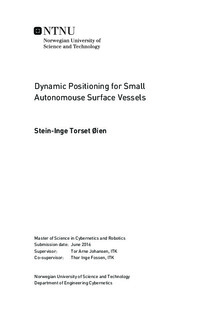Dynamic Positioning for Small Autonomouse Surface Vessels
Master thesis
Permanent lenke
http://hdl.handle.net/11250/2405543Utgivelsesdato
2016Metadata
Vis full innførselSamlinger
Sammendrag
The thesis seeks to prove that it is possible to implement dynamic positioning on small autonomous surface vessels by means of simple control and thrust allocation algorithms. Doing so without the need for observers and state estimation, wave filtering, detailed system identification and modeling. The thesis focuses primarily on functionality and practical implementation.
A DP control algorithm was developed, consisting of a 3-DOF nonlinear PID with a linear thrust allocation algorithm. A model of the vessel was also derived, approximated as a 3-DOF mass damper system. The DP control algorithm was tuned with pole placement based on the approximated model. Both the vessel model and control algorithm was prototyped and simulated in Matlab. A DP application, containing the DP control algoritm, was developed in Qt (C++). The application interfaces with the Telemetron vessel via TCP/IP, with a TCP client application implemented in the DP application. The functionality of the application was simulated locally before testing on the Telemetron vessel.
Three tests where completed, with focus on achieving DP and LSM objectives. The tests consisted of performing station keeping, translational and rotational maneuvers, in both a light and a moderate sea state. All objectives where accomplished when testing in a light sea state, with minor oscillations due to too aggressive proportional tuning. The test in with a moderate sea state managed to accomplish the station keeping objective, but failed to perform successfull low speed maneuvers, due to thrust allocation saturation. This was due to the thrust allocation output limitations being set too low, giving limiting the thrusters to less than 25\% of their maximum thrust output.
A re-test is proposed, with less proportional gain and increased maximum thrust output.
